You may recall me mentioning that the distance between any two consecutive notes on the piano is called a semitone. A semitone, also called a half-step, is just an interval, and every other interval is measured by its number of semitones. Before I explain this further, here's a list of all the intervals you will need to know:
1 Semitone - Minor Second
2 Semitones - Major Second
**3 Semitones - Minor Third**
**4 Semitones - Major Third**
**5 Semitones - Perfect Fourth**
6 Semitones - Tritone
**7 Semitones - Perfect Fifth**
8 Semitones - Minor Sixth
**9 Semitones - Major Sixth**
10 Semitones - Minor Seventh
11 Semitones - Major Seventh
**12 Semitones - Octave**
I've starred and bolded the ones that are important for now. Let's go over each of these individually:
Major Third
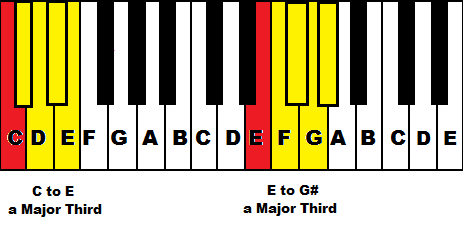
Remember that a major third is 4 semitones away from the starting note. C to E is a major third, and so is E to G# (because of the funky pairs of B/C and E/F).
Don't forget about the useful Virtual Keyboard so you can play the notes yourself to see what these intervals sound like.
Minor Third
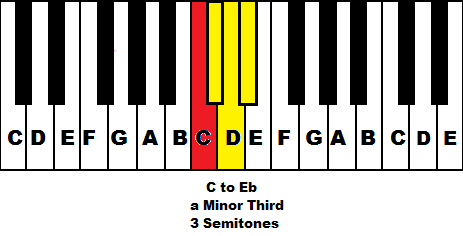
I decided to cover minor thirds after major thirds just because people generally cover major before minor when they learn music. Regardless, the concept is similar.
Minor thirds are 3 semitones away from their root notes. An Eb is 3 semitones above a C.
***Useful note: This will come up in the next lesson, but the third is the foundation of pretty much all chords. For example, a C chord is a C, a major third from C (which is E), and a minor third from E (which is G). Basically, if you can do thirds, you can do chords!**
Perfect Fourth and Fifths
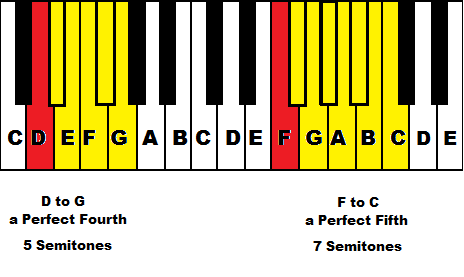
Fourths and Fifths are a little different. Unlike other intervals, fourths and fifths can never be major or minor, but cam only be perfect, augmented or diminished. Perfect fourths and fifth are the more commons ones, so let's just focus on those. As you can see, a note is a perfect fourth if it's 5 semitones away from the starting note and a perfect fifth if it's 7 semitones away.
Major Sixth
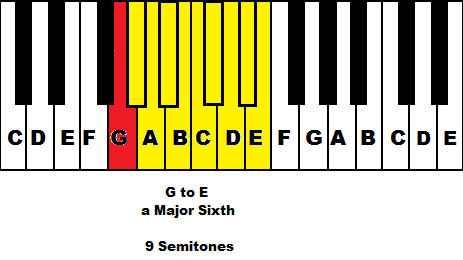
Self-explanatory at this point. 9 semitones will give you a major sixth.
Octave
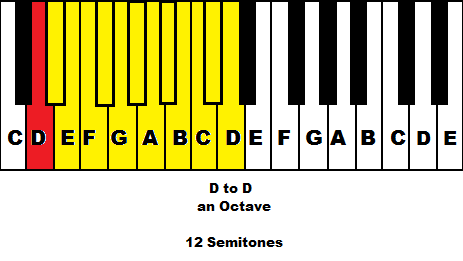
You can remember that an octave is 12 semitones, but the easiest way to remember is just that an octave is just the next instance of the same note on the piano (e.g., an octave from G is the next closest G in either direction).
There are a few other things I should note:
- The same interval from the same note in opposite directions will NOT yield the same pitch class. For example, a major sixth UP from C is an A, but a major sixth DOWN from C is an Eb.
- On the same note, in order to get to the same note going in one direction as the other, all you need to do is invert the interval and the quality. Here's what I mean:
If you go up a major sixth from C, you get an A. If you want to go DOWN to A from C, you invert the major sixth. To invert an interval, you subtract the number from 9 and invert the quality. Major and minor are inverses of each other, as are diminished and augmented (not covered here). Perfect stays perfect.
So, to invert the major sixth, major becomes minor, and then you subtract 6 from 9 (9 - 6 = 3). Therefore, the inverse of a major sixth is a minor third. In other words, going up a major sixth from C will yield the same pitch class as going down a minor third from C (A).
- Intervals from a minor second to an octave are simple intervals. Intervals above that are called compound intervals. To get the corresponding simple interval from a compound, simply subtract 7. For example, A major ninth is essentially the same thing as a major second (just separated by an additional octave).
Remember these intervals and simple tips, practice with them on a piano or the online keyboard, and you'll be able to not only play, but understand chords.
Next lesson: *guess what it is. Go on, guess*
CHORDS!!

No comments:
Post a Comment